Summary
World War II may be ending, but for 19-year-old bomber pilot, Henry Forester, the conflict still rages on. Shot down over France, Henry endured a dangerous trek to freedom, relying on civilians and French Resistance fighters to stay alive. But back home in Virginia, Henry is still reliving air battles with Hitler's Luftwaffe and his torture by the Gestapo. Henry worries about the safety of those who helped him escape—especially the young French boy, Pierre, who may have lost everything in his efforts to save Henry.
When Henry returns to France to find Pierre, he is stunned by the brutal aftermath of combat: widespread starvation, cities shattered by Allied bombing, and the return of survivors from the Nazi concentration camps. His efforts to find and secure the safety of Pierre help him to resolve the deep inner conflict he experiences at the beginning of the novel.
Relevance to other works by L.M. Elliott
Elliott is the author of novels for young adults, including "Annie, Between the States," a Civil War story which tracks how the upheaval of that conflict changes the life of the young heroine. Another work, "Give Me Liberty," recreates the rise of revolutionary fever in 1776 through the eyes of a young indentured servant who participates in one of the first battles of the war.
"Under a War-Torn Sky," the author's first novel of the two, tells the story of Henry Forester, a young pilot flying bombing missions in World War II. In the novel, Henry is trapped behind enemy lines; with the aid of resistance fighters (the Maquis) as well as a host of brave French citizens, he is eventually reunited with Allied forces. Elliott drew inspiration for the novel from the experiences of her own father, who served as a bomber pilot in World War II and had to rely on the courage of everyday French people to reach freedom.
This novel and the sequel, "A Troubled Peace," are works of historical fiction. The characters, dialog, and plot twists created by the author are crafted as believable, authentic representations. The author's first-hand research, including travel to sites in France described in the books, allows for specific references to actual geography and historical events; extensive secondary research (using rare print sources as well as actual artifacts) provides a level of historical detail that is not common in the genre. The author creates added texture with references to literature and music popular in the times described. (British novelist and critic George Orwell appears in one scene of the novel, and the work of Albert Camus is referred to.)
The author's works are noted for creating believable "coming of age" novels which make extensive use of the conflicts experienced by military personnel as well as civilians who have been swept up into war. Books by the author appear in school curricula throughout the United States and are popular on summer reading lists.
General information on the author and specific information for students, teachers, and media center specialists can be found on the author's website.
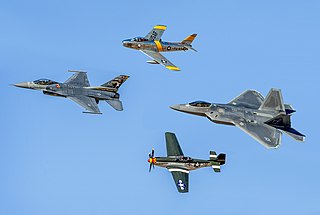
Fighter aircraft are fixed-wing military aircraft designed primarily for air-to-air combat. In military conflict, the role of fighter aircraft is to establish air superiority of the battlespace. Domination of the airspace above a battlefield permits bombers and attack aircraft to engage in tactical and strategic bombing of enemy targets.
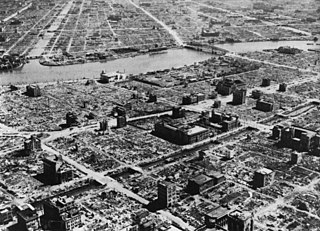
Strategic bombing is a military strategy used in total war with the goal of defeating the enemy by destroying its morale, its economic ability to produce and transport materiel to the theatres of military operations, or both. It is a systematically organized and executed attack from the air which can utilize strategic bombers, long- or medium-range missiles, or nuclear-armed fighter-bomber aircraft to attack targets deemed vital to the enemy's war-making capability.

The Battle of Britain, also known as the Air Battle for England, was a military campaign of the Second World War, in which the Royal Air Force (RAF) and the Fleet Air Arm (FAA) of the Royal Navy defended the United Kingdom (UK) against large-scale attacks by Nazi Germany's air force, the Luftwaffe. It has been described as the first major military campaign fought entirely by air forces. The British officially recognise the battle's duration as being from 10 July until 31 October 1940, which overlaps the period of large-scale night attacks known as the Blitz, that lasted from 7 September 1940 to 11 May 1941. German historians do not accept this subdivision and regard the battle as a single campaign lasting from July 1940 to June 1941, including the Blitz.

War and Peace is a literary work mixed with chapters on history and philosophy by the Russian author Leo Tolstoy, first published serially, then published in its entirety in 1869. It is regarded as one of Tolstoy's finest literary achievements and remains an internationally praised classic of world literature.

The Armée de l'Air is the name used for the French Air Force in its native language since it was made independent of the Army in 1933. This article deals exclusively with the history of the French air force from its earliest beginnings until its destruction after the occupation of France. French naval aviation, the Aéronautique Navale is covered elsewhere.

A flying ace, fighter ace or air ace is a military aviator credited with shooting down five or more enemy aircraft during aerial combat. The exact number of aerial victories required to officially qualify as an ace is varied, but is usually considered to be five or more.
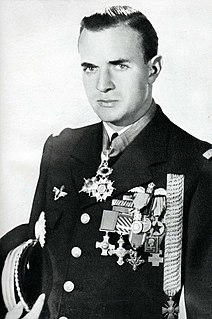
Pierre Henri Clostermann was a World War II French fighter pilot.

Air supremacy is a degree of air superiority where a side holds complete control of air power over opposing forces. There are levels of control of the air in warfare. Control of the air is the aerial equivalent of command of the sea.

Pierre Le Gloan was a French flying ace of World War II. Unique in the annals of wartime flying, he scored victories against German, Italian and British forces. Flying in the French and Vichy French air forces, his career has led some to call him the only pilot to become a flying ace on both sides of the war. He was killed in a landing accident in September 1943.
Piece of Cake is a 1983 novel by Derek Robinson which follows a fictional Royal Air Force fighter squadron through the first year of World War II, and the Battle of Britain. It was later made into the 1988 television serial Piece of Cake.
A war novel or military fiction is a novel about war. It is a novel in which the primary action takes place on a battlefield, or in a civilian setting, where the characters are preoccupied with the preparations for, suffering the effects of, or recovering from war. Many war novels are historical novels.
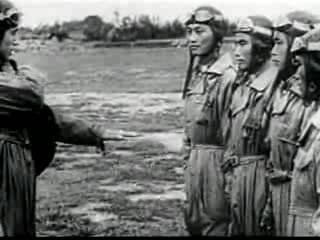
The Second Sino-Japanese War began on 7 July 1937 with the Marco Polo Bridge Incident in the Republic of China and is often regarded as the start of World War II as full-scale warfare erupted with the Battle of Shanghai, and ending when the Empire of Japan surrendered to the Allies in August 1945. The Chinese Air Force faced the Imperial Japanese Army and Navy Air Forces and engaged them in many aerial interceptions, including the interception of massed terror-bombing strikes on civilian targets, attacking on each other's ground forces and military assets in all manners of air-interdiction and close-air support; these battles in the Chinese skies were the largest air battles fought since the Great War, and featured the first-ever extensive and prolonged deployment of aircraft carrier fleets launching preemptive strikes in support of expeditionary and occupational forces, and demonstrated the technological shift from the latest biplane fighter designs to the modern monoplane fighter designs on both sides of the conflict.
Under a War-Torn Sky is a young adult war novel about a young man flying a B-24 in World War II. When his plane is shot down and he is trapped behind enemy lines, he is helped by kind French citizens to escape and get back to his home. Written by American author L.M. Elliott, the novel was first published in 2001. It won a number of awards on publication and has sold over 200,000 copies in the U.S. and abroad.

Bows Against the Barons is a 1934 children's novel by British author Geoffrey Trease, based on the legend of Robin Hood. It tells the story of an adolescent boy who joins an outlaw band and takes part in a great rebellion against the feudal elite. Trease's first novel, Bows Against the Barons marks the start of his prolific career as a historical novelist. It is notable for reinterpreting the Robin Hood legend and revitalizing the conventions of children's historical fiction in 20th-century Britain.
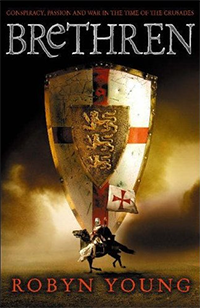
Brethren is a novel written by Robyn Young set in the ninth and last crusade. It was published by Hodder and Stoughton in 2006. It took her seven years to write the novel where she was "intrigued by the idea of these medieval warrior monks".

Heroes Over Europe is an arcade flying video game developed by Transmission Games and published by Ubisoft. It is the sequel to Heroes of the Pacific.

L.M. Elliott is pen name of Laura Malone Elliott. She was born on September 17, 1957, close to Washington, DC. award-winning author of young adult novels, including Under a War-Torn Sky (2001), Flying South (2003), Give Me Liberty (2008), and A Troubled Peace (2009), the sequel to Under a War-Torn Sky.

Aircraft in fiction covers various real-world aircraft that have made significant appearances in fiction over the decades, including in books, films, toys, TV programs, video games, and other media. These appearances spotlight the popularity of different models of aircraft, and showcase the different types for the general public.

Air warfare was a major component in all theaters of World War II, and, together with anti-aircraft warfare, consumed a large fraction of the industrial output of the major powers. Germany and Japan depended on air forces that were closely integrated with land and naval forces; the Axis powers downplayed the advantage of fleets of strategic bombers, and were late in appreciating the need to defend against Allied strategic bombing. By contrast, Britain and the United States took an approach that greatly emphasised strategic bombing, and tactical control of the battlefield by air, as well as adequate air defences. Both Britain and the U.S. built a substantially larger strategic forces of large, long-range bombers. Simultaneously, they built tactical air forces that could win air superiority over the battlefields, thereby giving vital assistance to ground troops. The U.S. and Royal Navy also built a powerful naval-air component based on aircraft carriers, as did the Japanese; these played the central role in the war at sea.
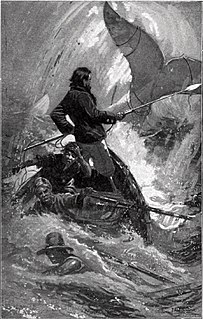
Nautical fiction, frequently also naval fiction, sea fiction, naval adventure fiction or maritime fiction, is a genre of literature with a setting on or near the sea, that focuses on the human relationship to the sea and sea voyages and highlights nautical culture in these environments. The settings of nautical fiction vary greatly, including merchant ships, liners, naval ships, fishing vessels, life boats, etc., along with sea ports and fishing villages. When describing nautical fiction, scholars most frequently refer to novels, novellas, and short stories, sometimes under the name of sea novels or sea stories. These works are sometimes adapted for the theatre, film and television.

















